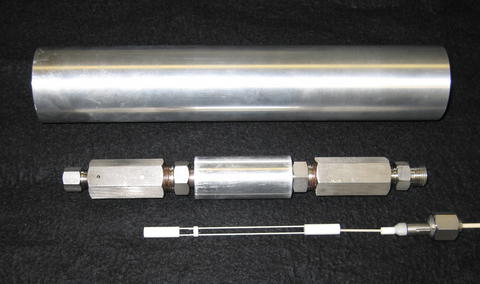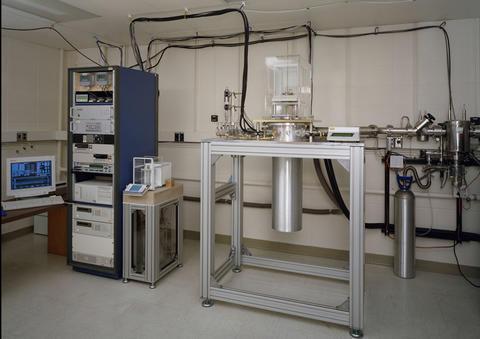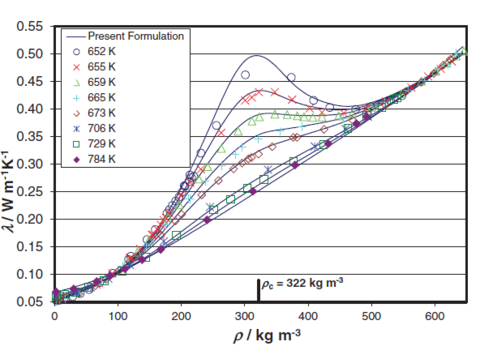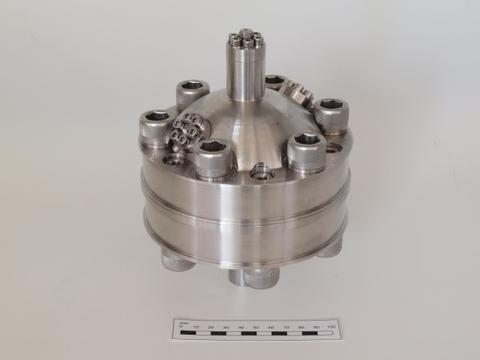Summary
Property measurements of the very highest accuracies are important for developing the thermodynamic and transport property models for working fluids and reference fluids. More than simply providing data for a high-accuracy equation for, say, a refrigerant, our work, in collaboration with our theoretical colleagues, advances fluid property theory in general. This is the concept of a reference fluid—extensive, high-accuracy data on key fluids allow the development of improved equations of state (for the calculation of thermodynamic properties) and transport property models. These reference fluid formulations characterize the behavior of broad ranges of chemically similar fluids; in this way data on propane, for example, are used to improve the property models for a broad range of hydrocarbons that have limited data.
Description
State-of-the art property measurements have been the hallmark of the Fluid Properties Group for more than four decades. Many of these measurements have been carried out on one-of-a-kind instruments developed at NIST. In some cases the older instruments are still among the very best of their kind, and we continue to use them. We have also developed new instruments in recent years that have advanced the state of the art. Our research in this area takes the form of extensive measurements of the highest accuracy on reference fluids and certification of Standard Reference Materials; these complement more limited measurements on systems of industrial interest (described under working fluids and fuels).
Densimeters for Fluid (p-ρ-T) Measurements
We have developed two magnetic suspension densimeters in recent years for high-accuracy fluid p-ρ-T (pressure-density-temperature) measurements over wide ranges of temperature and pressure. A two-sinker instrument was developed in collaboration with Rubotherm GmbH of Bocum, Germany. This instrument applies the Archimedes (bouyancy) principle together with a magnetic suspension coupling to separate the sinkers (sensing elements) from the balance that weighs them to allow measurements over very wide ranges of temperature and pressure (220 K to 505 K, with pressures to 40 MPa). This instrument is one of only a handful of its kind worldwide and is the world's most accurate instrument for wide-ranging density measurements. In addition to developing the densimeter (which was largely fabricated in the NIST Instrument Shops), we have advanced this general type of instrument by analyzing the effects of the so-called "force transmission error." We have also developed a single-sinker hydrostatic-balance densimeter operating at temperatures up to 400 °C and pressures to 50 MPa (also in collaboration with Rubotherm).
AC Hot Wire Instruments for Thermal Conductivity

Transient hot-wire instruments for thermal conductivity measurements are traditionally operated with a DC drive voltage to heat the wires and measure the temperature increase during the experiment. This works well for non-polar and electrically insulating fluids or for hot wires that have good electrical insulation from the fluid, such as anodized tantalum hot wires at moderate temperatures. When it is not possible to reliably insulate the hot wires from the fluid, the use of an AC drive voltage at an appropriate frequency can be an effective way to eliminate measurement errors due to polarization of the fluid around the hot wires during the transient experiment. The transient hot-wire instruments at NIST have been modified to allow either traditional DC experiments or AC experiments with digital lock-in amplifier detection of the temperature increase during the experiment. The frequency of the AC drive voltage can be varied from 1000 Hz to 30 kHz to find an appropriate frequency where the electric field around the wires is changing too rapidly to allow significant polarization of the fluid (typically ionic double-layer formation). The two techniques have been show to give equivalent results for the thermal conductivity of non-polar fluids.
Standard Reference Materials for Density

Most industrial densimeters (instruments that measure fluid density) require regular calibration with a fluid of known density, and NIST sells Standard Reference Materials® (SRMs) for this purpose. The two-sinker magnetic suspension densimeter was used to extend the certification of the SRM for liquid density based on toluene from the near-ambient conditions of the previous SRM to the temperature range –50 °C to 150 °C, with pressures to 30 MPa; this is the widest range of temperature and pressure for a density standard from any National Metrology Institute.
https://www-s.nist.gov/srmors/view_detail.cfm?srm=211D
A similar project to extend the range of the iso-octane standard is in progress.
Density and Heat Capacity of Propane
We carried out extensive measurements of the p-ρ-T (pressure-density-temperature), heat capacity at constant volume CV, and heat capacity at saturation Csat of propane. The data covered a combined temperature and pressure range of 85 K to 500 K, with pressures up to 36 MPa. The sample used was of the very highest purity available—99.999 %. The p-ρ-T data were also used to establish the critical point of propane, and the Csat data established the vapor pressure from the triple point to the normal boiling point. These were key data in developing a new equation of state that is among the most accurate for any fluid. Propane is an excellent reference fluid for the entire class of aliphatic hydrocarbons, and the new equation of state will be applied to many industrial systems, including natural gases and liquid fuels.
Transport Properties of Water/Steam
The Thermophysical Properties Division is working with the International Association for the Properties of Water and Steam (IAPWS - http://www.iapws.org) and the International Association for Transport Properties (IATP) on the development of reference formulations for the viscosity and thermal conductivity of water and steam. These new correlations for viscosity and thermal conductivity are based on the current IAPWS formulations for thermodynamic properties of water and steam. The formulation for viscosity has been approved by IAPWS. Detailed documentation of the development and evaluation of the viscosity formulation in the critical region and over the entire range of applicability has also been published. The viscosity formulation covers fluid states of H2O up to 1173 K and 1000 MPa with uncertainties from less than 1% to 7% depending on the state point.

A new formulation for thermal conductivity has been developed and IAPWS has appointed a task group to evaluate the proposed formulation. The development task group (which includes representatives from the Thermophysical Properties Division) will respond to any concerns raised by the evaluation task group and document the new formulation for thermal conductivity, which can then be considered by IAPWS for adoption as an IAPWS release. The development of this formulation in the critical region is based on evaluation of theory relative to thermal diffusivity data from light scattering very near the critical point.
Release on the IAPWS Formulation 2008 for the Viscosity of Ordinary Water Substance,http://www.iapws.org.

Transport Properties of Hydrogen
The Thermophysical Properties Division began its study of the thermodynamic and transport properties of normal and para hydrogen at cryogenic temperatures nearly 50 years ago for the U.S. space program. Standard formulations for the viscosity and thermal conductivity over wide ranges of temperature and pressure are needed due to renewed interest in hydrogen for fuel applications that may provide an alternative to increasing CO2 generation by conventional combustion processes. We are currently measuring the thermal conductivity of normal hydrogen at temperatures up to 700 K with pressures up to 70 MPa to complement our previous cryogenic work and the available literature. We have documented ab-initio quantum calculations of the dilute-gas viscosity and thermal conductivity of ortho, para, and normal hydrogen that provides reliable extrapolation to extreme temperatures where measurements are difficult and sometimes unreliable. We are currently working on reference formulations for the viscosity and thermal conductivity of normal and para hydrogen over the temperature range from the triple point to 1000 K and pressures up to 100 MPa.
Virial Coefficients of Helium
In a collaboration with Dr. Michael Moldover of the NIST Physical Measurement Laboratory, p-ρ-T(pressure-density-temperature) measurements on helium using our two-sinker densimeter were combined with theory to yield the most accurate virial coefficients available for this gas. The approach was to constrain the fit of the experimental data using second and third virial coefficients calculated from first principles. New fitting parameters were introduced in the analysis to account for small, systematic errors in the experimental data; although small (e.g. one parameter corrected for weighing errors on the order of a few micrograms), including these parameters reduced the uncertainty in the fourth virial coefficient by a factor of six compared with the traditional analysis of p-ρ-T data. These data will be used in the development of a new primary pressure standard based on fundamental physical properties of helium.
http://www.nist.gov/pml/div685/grp02/atomic_standard.cfm

